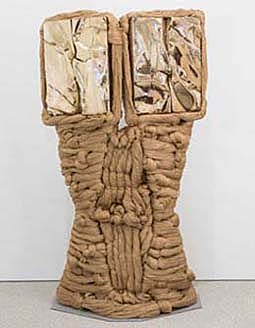Alberto Giacometti had never been to New York, but he had plans for Lower Manhattan. When Chase Bank came to him in 1958, he envisioned one of his striding figures, amid the movers and shakers streaming through the bank’s plaza.
It never came, but seven of his works in plaster are standing tall at the Museum of Modern Art, amid work by Barbara Chase-Riboud, through October 9. They may seem an odd couple—a living artist and a giant of Modernism, a black woman and a Swiss gentleman who had his studio in Paris for more than forty years. Still, thanks to MoMA, his influence is unmistakable, and so is her challenge. Besides, as she titled more than one sculpture, All That Rises Must Converge. And I bring this together with an earlier report on Georgia O’Keeffe drawings at the Modern as a longer review and my latest upload.
It is easy enough to number the differences between sculptors. Alberto Giacometti literally got his hands dirty, working in plaster, at times with a pocket knife. Barbara Chase-Riboud begins the old way with “lost-wax” casts, before pouring molten metal into the molds. His figures are gaunt to the point of tortured, hers bulking outward as they rise. Her Woman’s Monument might be sustained by its flowing robe—and might be facing down a wall. The small plates of Cleopatra’s golden cape, in copper and bronze, glisten.
His figures are of indeterminate gender or color, hers proudly female and black. Still, he identifies his as either men or women, including Spoon Woman from the 1920s and Woman with Her Throat Cut from 1932, neither in the show. The seven plasters round out his Femmes de Venise, all but one from the 1950s. She has her own Standing Black Woman of Venice, black of course, from 1969. A dark obelisk, it looms over his Tall Figure in MoMA’s collection, itself larger than his women, on the same platform. She comes closer still to Giacometti with The Couple, a jagged mass on spindly legs, but then her figures are never altogether alone.
Chase-Riboud moved to Paris, too, as still a young woman, and wasted no time in heading for his studio. She likes to remember plaster dust covering everything. It was right around when he was abandoning the commission for Chase, which went instead to Jean Dubuffet. Still, they may get the better site, a room outside the postwar collection. One can see echoes of the wavy surface of her flattest tower in the garden fountain below. Giacometti has engaged viewers directly with his Hands Holding the Void (Invisible Object) ever since MoMA’s 2019 expansion gave renewed weight to its collection.
The pairing acts on the museum’s promise to rehang the collection every year, with its “fall reveal.” Curated by MoMA’s Christophe Cherix and Emilie Bouvard of the Fondation Giacometti, which lent the seven works in plaster, turns for hers to the Met, the Studio Museum in Harlem, and private collections as well. All told, she gets the better of the deal. She forms the backdrop on the platform, as if setting the stage for both, while larger and smaller work stands apart to all sides. It has much in common with another spanning Modernism and African American art, Melvin Edwards. He, too, prefers the weight of metal to plaster casts.
 She works in another marker of difference at that, raw fibers. They pun on the metal “fabric” of Cleopatra’s cape, but they take on a greater weight of their own. They may lie above or beneath the rest, on the floor or suspended from the wall, or work their way into the bronze. No question, though, but she discovered herself only after her student years and her visit to Giacometti. Then all she had to do was to shed his overwhelming influence by getting past The Couple. Also a novelist and poet, she could still keep two things crucial to his work, the human figure and the ambiguity.
She works in another marker of difference at that, raw fibers. They pun on the metal “fabric” of Cleopatra’s cape, but they take on a greater weight of their own. They may lie above or beneath the rest, on the floor or suspended from the wall, or work their way into the bronze. No question, though, but she discovered herself only after her student years and her visit to Giacometti. Then all she had to do was to shed his overwhelming influence by getting past The Couple. Also a novelist and poet, she could still keep two things crucial to his work, the human figure and the ambiguity.
Are his in an existential crisis or in command, and is this a tamer Giacometti, without the nightmares? Are his void and his spoon half empty or half full? In the same way, her sculpture could indeed be rising or falling. Her titles speak of Africa Rising and All That Rises (adapted from a Southern white writer, as a matter of fact, Flannery O’Connor), and two parts of Albino may well rise to rise to either side, pinned at top to the wall. Yet the mass of metal and fabric at center seems to have fallen of its own weight to the floor. At eighty-three, with her own public sculpture in Manhattan, she sat through the press preview, and she may find it harder and harder to rise.
Read more, now in a feature-length article on this site.
